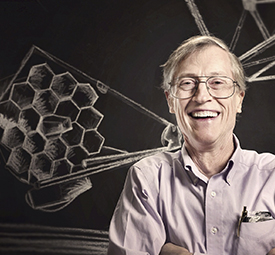Dr. Mather grew up in rural N.J. living on a scientific research facility where his father studied dairy cows. He attended public schools, learned calculus from a book, received a bachelor’s degree in physics from Swarthmore College in Pa., and wanted to be like Richard Feynman. But his doctorate in physics from the University of California, Berkeley led him into observations of the Big Bang, with an unsuccessful thesis project that nevertheless inspired the Cosmic Background Explorer (COBE) satellite and a Nobel Prize.
As a National Research Council postdoctoral fellow at the Goddard Institute for Space Studies in New York City, he led the proposal efforts for the COBE mission from 1974-76 and moved to the Goddard Space Flight Center to be the lead scientist for the mission.
Dr. Mather and the COBE team showed that the cosmic microwave background radiation has a blackbody spectrum within 50 parts per million (ppm), confirming the expanding universe concept, or the Big Bang theory, to extraordinary accuracy. The team also measured hot and cold spots in the heat radiation. Steven Hawking said it was the greatest scientific discovery of the century, if not of all time.
As senior project scientist (1995-present) for the Webb telescope, Dr. Mather leads the science team and represents scientific interests within the project management.
As winner of the 2006 Nobel Prize for Physics, chosen by the Royal Swedish Academy of Sciences, Dr. Mather shares the prize with George F. Smoot of the University of California for their work using the COBE satellite to measure the heat radiation from the Big Bang. Dr. Mather put his prize money into the John and Jane Mather Foundation for Science and the Arts. He also sponsors summer interns to work on science policy on Capitol Hill, through the Society of Physics Students.
Bio courtesy of Dr. John C. Mather

